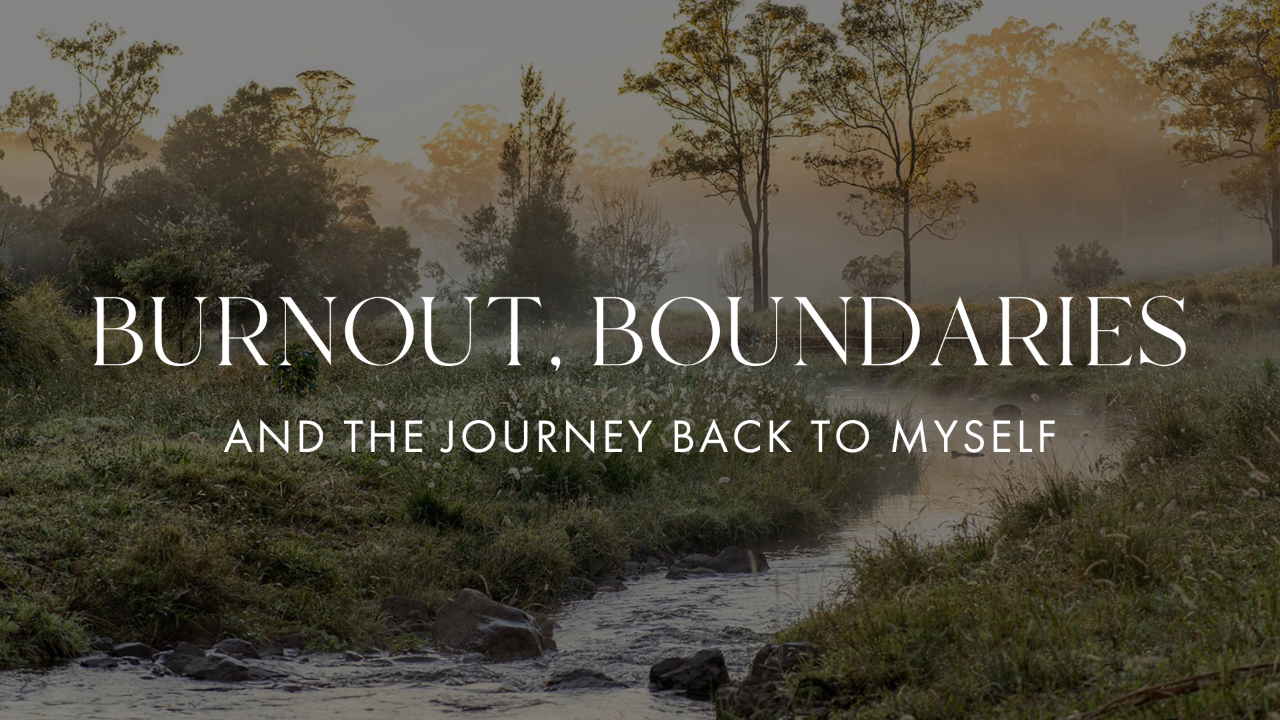Burnout, Boundaries & the Journey Back to Myself

For a long time, I was ignoring the signs.
The exhaustion, the brain fog, the emotional overwhelm—I chalked it up to the demands of motherhood, business, and life. I pushed through, ignoring the signals my body was desperately sending.
Until I couldn’t anymore.
At the end of 2023, my health hit a wall. I was juggling an 18-month-old, two older children, a business, and the never-ending mental load that so many women carry. But something felt off. No matter how much I slept, I woke up exhausted. Bone achingly exhausted. My emotions felt raw, my mind clouded, and despite trying everything, nothing seemed to help.
Doctors ran tests. Everything came back “normal.”
But I knew this wasn’t normal.
The Reality of Burnout
It wasn’t until a friend introduced me to Chris & Filly and their Ending Body Burnout program that I finally got answers. My body wasn’t just tired—it was depleted. Tests revealed adrenal fatigue, SIBO, low serotonin, low dopamine and reduced liver function. My ne...
The Intention Guiding my 2025

For the past 10 years, I’ve started each year with an intentional planning session—a ritual that’s helped me realign, refine, and design a life I love. What once felt like a complete reset at the beginning of each year, is now about softening into more of what I love and making small, meaningful tweaks that align with who I am becoming.
This year, I had the privilege of guiding a group of ambitious businesswomen through this process at my Business Planning Day in January. A large part of the day was focused on getting clear on what we truly want from life—because only when we define that vision can we build businesses that support it. Too often, we find ourselves designing our lives around our work, when in reality, our businesses should be designed to enable the lives we desire.
Over the years, I’ve shifted away from traditional goal-setting and instead embraced intentions over goals. Goals can feel like another task on a never-ending to-do list, while intentions shape the way we sh...
The Future of Work is a partnership of People, Culture & Place

A new approach to workplaces
For decades, organisations have viewed the functions of People & Culture and Property as separate entities.
The former focused on workforce engagement, talent strategies, and leadership development, while the latter managed physical workspaces as financial assets, often sitting under Finance or Operations.
But what if the future of work calls for a fundamental shift — one where workplaces are no longer just ‘assets’ to optimise, but strategic tools designed to enhance human potential?
At LEGO, they’ve already embraced this shift. Their workplace function now reports into their Chief People Officer, rather than Operations or Finance. Why? Because as workplace leaders at LEGO explain, when you see real estate as an asset, you focus on optimising the space itself. But under People & Culture, the goal shifts from optimising an asset based on cost and efficiency, to maximising people’s performance potential.
This subtle change is reframing how organisa...
Your Workplace is a Cultural Canvas

Bringing your business story and aspirational culture to life
Your workplace isn’t just a physical space; it’s a cultural canvas.
It’s where your organisation’s vision, values, and purpose come to life — connecting employees and clients in a meaningful way.
When you think of iconic brands like Apple, their products are just one part of the story. Their sleek, welcoming stores and thoughtfully designed workplaces are integral to the holistic experience they deliver. These intentional workspaces reflect the sentiment of their vision, and purpose: simplicity, innovation, and creativity.
For organisations that want to embody their purpose in every interaction, the takeaway is clear: a space designed with strategic intent becomes a powerful tool for telling your brand story and cultivating aspirational culture.
Why a Workplace Strategy matters for CEOs and People & Culture Managers
A well-executed workplace strategy can transform your office into a space that actively communicates...
Is a Workplace Strategy worth the investment?

It’s not just about what you save, it’s about what you gain
*Spoiler alert* It will come as no surprise that this article concludes that absolutely yes, a Workplace Strategy is worth the investment — Workplace Strategies are core to what we do at COMUNiTI. But what might surprise you is the returns that the right Workplace Strategy can deliver, beyond savings per m2.
You see, not all Workplace Strategies are created equal.
There are Workplace Strategies that just give you a design brief, and this might help you improve the aesthetics of your workplace and save some square meterage costs. ✅
And then there are Workplace Strategies that unlock a much bigger return on your investment. These Workplace Strategies are data-driven and strategically tailored to your organisation’s vision, goals, values, unique brand story, aspirational culture, and operational needs. ✅✅✅
They are developed by Workplace Strategists who know how to form a much deeper understanding of your business and ...
What is the role of a Workplace Strategist?

What is the role of a workplace strategist?
A guide for People & Culture leaders
The role of a Workplace Strategist has gained a lot of attention post-pandemic as businesses focus on attracting and retaining talent and enticing people back into the office.
But what exactly does a Workplace Strategist do, and how can we help People & Culture leaders drive employee engagement?
💫 What we do
Workplace Strategists leverage design thinking principles with an analytical business mindset.
We create a strategic framework that captures the complex essence of your business — your unique operational structure, how it functions, how employees interact, and how your office space can support these dynamics.
Rather than jumping straight into the planning phase and putting desks and offices onto a floor plan, a Workplace Strategist knows how to transcend aesthetics and deliver a workspace that aligns with your company’s mission, values, and goals, while elevating the employee experience a...
What is a Workplace Strategy?

First published on COMUNiTI, September 2024
How People & Culture teams are repositioning this Boardroom conversation
“Can you help me explain what a workplace strategy is, to my leadership team?”
It’s a question that we get asked a lot at COMUNiTI, and it’s easy to understand why: while workplace strategy is a pivotal concept for forward-thinking organisations, it continues to be misunderstood among many executive teams, who consider their workplace as simply a “place to accommodate people to work”, resulting in a desk + chair approach where they see no strategy is needed.
Re-imagining, redesigning, recreating, and rebuilding a workplace often falls in the remit of the Facilities Management, Operations, or Accommodation teams. HOWEVER, what this approach fails to acknowledge is that our workplaces are created for PEOPLE. To ensure that organisations consider all aspects of what people need to thrive at work, the workplace strategy conversation must be three-way between the Facil...
Will a workplace refurbishment attract people back into the office?

First published on COMUNiTI, September 2024
Making the office better than home
Commentary on return-to-office mandates certainly heated up in recent weeks following the NSW Premier’s directive for employees across the public service to work principally from an approved workplace. While this mandate appears to be less about concerns relating to employee productivity and more to do with the reactivation and revitalisation of the city centres [a whole other conversation!], employee reactions to mandates remain unchanged.
While some organisations are mandating employees return to the office, others are exploring a motivation-based approach, with the state of their workplace being a key consideration.
And, it’s an important strategy.
The average workplace experience, as measured through the Leesman Index score (Lmi) has increased by nearly four points from 64.3 pre-pandemic to 67.9 post-pandemic. Organisations are clearly investing in workplace improvements to make the office more app...
Is your workplace helping or hindering company culture?

First published on COMUNiTI, August 2024
How workplace strategy helps teams 'live the values'
Is your workplace helping or hindering company culture?
When I engage with new clients, I am quickly curious about their company values. Whether they are written in a strategy document, printed and hung on the walls, or just shared as a general feeling of what's important - it's crucial to for us understand whether the physical workspace drives values-aligned behaviours.
So often we find that the office layout and design is really misaligned.
What do I mean?
When creating a new workplace we can influence people to act in a way that aligns with the organisation’s desired outcomes. I do this by introducing different types of work spaces and zoning areas to consolidate similar types of activities and environmental cues like texture and colour. This thinking is based on nudge theory, which is a behavioural science concept that proposes we can influence the behaviours and decisi...
The secret to successful placemaking?

First published on COMUNiTI, April 2024
Look beyond the walls and workstations
"Building a community outshines workplace design."
This is my philosophy on successful placemaking.
When I embark on workplace redesign, my primary goal is to build a strong, interconnected community. Why? Because a thriving community is a surer road to achieving organisational objectives than just focussing on the desks, decor, walls and workstations.
Sure, office layout and aesthetics matter, but they shouldn't overshadow the ultimate goal of placemaking: creating a collaborative, productive, thriving community, where everyone feels connected to purpose.
When I guide clients through a a community-centric approach to workplace redesign I help shift the collective mindset from ‘we’re redesigning the workplace’ to ‘we’re building a thriving community’.
This means I’m not just answering the question: "How many desks do you need to fit on the floorplan?" By reframing the conversation from work...

